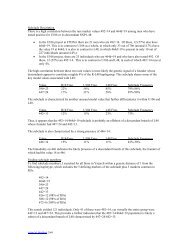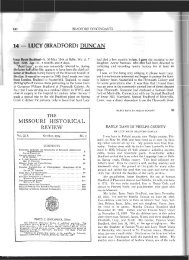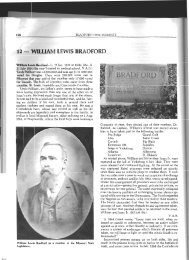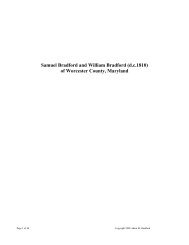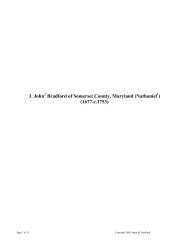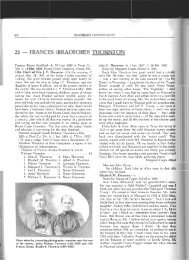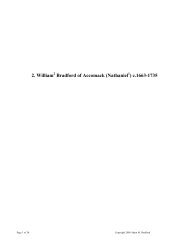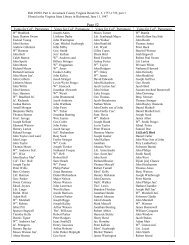1. Nathaniel Bradford of Accomack County, Virginia - Lower ...
1. Nathaniel Bradford of Accomack County, Virginia - Lower ...
1. Nathaniel Bradford of Accomack County, Virginia - Lower ...
Create successful ePaper yourself
Turn your PDF publications into a flip-book with our unique Google optimized e-Paper software.
John Smith’s map <strong>of</strong> <strong>Virginia</strong>. The peninsula <strong>of</strong> the eastern shore is at the bottom.<br />
Brief History <strong>of</strong> the <strong>Virginia</strong> Colony on the Eastern Shore to 1654<br />
English settlement on the mainland <strong>of</strong> <strong>Virginia</strong> first began in the<br />
spring <strong>of</strong> 1607, with the founding <strong>of</strong> Jamestown [depicted left] by<br />
the <strong>Virginia</strong> Company <strong>of</strong> London. The following year Captain<br />
John Smith, one <strong>of</strong> the leaders <strong>of</strong> the new colony, set forth on an<br />
exploration <strong>of</strong> the Chesapeake Bay, in the course <strong>of</strong> his journey<br />
touching down at several spots on the eastern shore and even being<br />
hosted by the Indians there. The first settlement on the east side <strong>of</strong><br />
the Chesapeake occurred in 1614 when Sir Thomas Dale sent a<br />
small group <strong>of</strong> men to Smith’s Island to engage in fishing and salt<br />
production. After a few years the salt works had fallen into disuse and the island was abandoned, but in<br />
1619 the activities <strong>of</strong> Thomas Savage, who was engaged in trade with the local Indians on the shore,<br />
revived interest in settlement. A year later the first <strong>Virginia</strong>ns began to arrive from across the bay and<br />
settled on land set aside by the Company in the south <strong>of</strong> the peninsula on Old Plantation Creek. This was<br />
the first permanent settlement <strong>of</strong> the English in <strong>Accomack</strong>.<br />
The year 1622 saw a tremendous uprising <strong>of</strong> numerous western shore Indian<br />
tribes against the encroaching English [depicted left]. This constituted a<br />
serious attempt to eliminate the European presence in <strong>Virginia</strong>, and about a<br />
third <strong>of</strong> the fledgling colony’s inhabitants lost their lives. A bitter and brutal<br />
war ensued that lasted for much <strong>of</strong> the decade. However, the natives <strong>of</strong><br />
<strong>Accomack</strong> took no part in the massacre and as a result the colonists there were<br />
spared not only the initial violence itself, but also its bloody aftermath. So<br />
fearful was the mood <strong>of</strong> the colonists on the western shore after the massacre that there was talk among the<br />
government at Jamestown <strong>of</strong> relocating the capital to the eastern shore. Any idea <strong>of</strong> fleeing Jamestown was<br />
quickly set aside as being born <strong>of</strong> “a Panicke feare”, although the colony’s leaders did write to the company<br />
Page 4 <strong>of</strong> 74 Copyright 2008 Adam M. <strong>Bradford</strong>





